Mineral Chemistry of Low-Temperature Phyllosilicates in Early Paleozoic Metaclastic Rocks, Eastern Tauride Belt, Türkiye
Abstract
:1. Introduction
2. Geological Setting and Stratigraphy
3. Materials and Methods
4. Results
4.1. Texture
4.2. Mineralogy
4.3. Mineral Chemistry
5. Discussion
5.1. Chlorite Chemistry
5.2. Illite/White Mica Chemistry
6. Conclusions
Author Contributions
Funding
Acknowledgments
Conflicts of Interest
References
- Robinson, D. Transition from diagenesis to metamorphism in extensional and collision settings. Geology 1987, 15, 866–869. [Google Scholar] [CrossRef]
- Merriman, R.J.; Frey, M. Patterns of very low grade metamorphism in metapelitic rocks. In Low-Grade Metamorphism; Frey, M., Robinson, D., Eds.; Blackwell Science: Oxford, UK, 1999; pp. 61–107. [Google Scholar]
- Voll, G. New work on petrofabrics. Liverp. Manch. Geol. J. 1960, 2, 503–567. [Google Scholar] [CrossRef]
- Craig, J.; Fitches, W.R.; Maltman, A.J. Chlorite-mica stacks in low-strain rocks from Central Wales. Geol. Mag. 1982, 119, 243–256. [Google Scholar] [CrossRef]
- Giorgetti, G.; Memmi, F.; Nieto, F. Microstructures of intergrown phyllosilicate grains from Verrucano metasediments (northern Apennines, Italy). Contrib. Mineral. Petrol. 1997, 128, 127–138. [Google Scholar] [CrossRef]
- Kisch, H.J. Mineralogy and petrology of burial diagenesis (burial metamorphism) and incipient metamorphism in clastic rocks. In Diagenesis in Sediments and Sedimentary Rocks; Larsen, G., Chilingar, G.V., Eds.; Elsevier: Amsterdam, The Netherlands, 1983; Volume 2, pp. 289–493; 513–541. [Google Scholar]
- Frey, M. Very low-grade metamorphism of clastic sedimentary rocks. In Low Temperature Metamorphism; Frey, M., Ed.; Blackie & Son: Glasgow, UK, 1987; pp. 9–58. [Google Scholar]
- Merriman, R.J.; Peacor, D.R. Very low-grade metapelites: Mineralogy, microfabrics and measuring reaction progress. In Low-Grade Metamorphism; Frey, M., Robinson, D., Eds.; Blackwell Science: Oxford, UK, 1999; pp. 10–60. [Google Scholar]
- Ferreiro-Mählmann, R.; Bozkaya, Ö.; Potel, S.; Le Bayon, R.; Nieto, F. The pioneer work of Bernard Kübler and Martin Frey in very low-grade metamorphic terranes: Paleo-geothermal potential of variation in Kübler-Index/organic matter reflectance correlations. A review. Swiss J. Geosci. 2012, 105, 121–152. [Google Scholar] [CrossRef]
- Ireland, B.J.; Curtis, C.D.; Whiteman, J.A. Compositional variation within some glauconites and illites and implications for their stability and origins. Sedimentology 1983, 30, 769–786. [Google Scholar] [CrossRef]
- Hunziker, J.C.; Frey, M.; Clauer, N.; Dallmeyer, R.D.; Fredrichsen, H.; Flehmig, W.; Hochstrasser, K.; Roggviler, P.; Schwander, H. The evolution of illite to muscovite: Mineralogical and isotopic data from the Glarus Alps. Switzerland. Contrib. Mineral. Petrol. 1986, 92, 157–180. [Google Scholar] [CrossRef]
- Brill, B.A. Illite crystallinity, b0 and Si content of K-white mica as indicators of metamorphic conditions in low-grade metamorphic rocks at Cobar, New South Wales. Aust. J. Earth Sci. 1988, 35, 295–302. [Google Scholar] [CrossRef]
- Weaver, C.E. Shale Slate Metamorphism in Southern Appalachians; Elsevier: Amsterdam, The Netherlands, 1984. [Google Scholar]
- Cathelineau, M.; Nieva, D.A. Chlorite solid solution geothermometer, the Los Azufres geothermal system (Mexico). Contrib. Mineral. Petrol. 1985, 91, 235–244. [Google Scholar] [CrossRef]
- Cathelineau, M. Cation site occupancy in chlorites and illites as a function of temperature. Clay Miner. 1988, 23, 471–485. [Google Scholar] [CrossRef]
- Velde, B.; Medhioub, M. Approach to chemical equilibrium in diagenetic chlorites. Contrib. Mineral. Petrol. 1988, 98, 122–127. [Google Scholar] [CrossRef]
- Hillier, S.; Velde, B. Octahedral occupancy and the chemical composition of diagenetic (low temperature) chlorites. Clay Miner. 1991, 26, 149–168. [Google Scholar] [CrossRef]
- Jahren, J.S.; Aagard, P. Diagenetic illite-chlorite assemblages in arenites. I. Chemical evolution. Clays Clay Miner. 1992, 40, 540–546. [Google Scholar] [CrossRef]
- Xie, X.G.; Byerly, G.R.; Ferrell, R.E. IIb trioctahedral chlorite from the Barberton greenstone belt: Crystal structure and rock composition constraints with implications to geothermometry. Contrib. Mineral. Petrol. 1997, 126, 275–291. [Google Scholar] [CrossRef]
- Potel, S.; Ferreiro-Mählmann, R.; Stern, W.B.; Mullis, J.; Frey, M. Very low-grade metamorphic evolution of pelitic rocks under high-pressure/low-temperature condition, NW New Caledonia (SW Pacific). J. Petrol. 2006, 47, 991–1015. [Google Scholar] [CrossRef]
- Hillier, S.; Velde, B. Chlorite interstratified with a 7 Å mineral: An example from offshore Norway and possible implications for the interpretation of the composition of diagenetic chlorites. Clay Miner. 1992, 27, 475–486. [Google Scholar] [CrossRef]
- Hillier, S. Origin, diagenesis, and mineralogy of chlorite minerals in Devonian lacustrine mudrocks, Orcadian Basin, Scotland. Clays Clay Miner. 1993, 41, 240–259. [Google Scholar] [CrossRef]
- Jiang, W.T.; Peacor, D.R. Formation of corrensite, chlorite and chlorite-mica stacks by replacement of detrital biotite in low-grade pelitic rocks. J. Metamorph. Geol. 1994, 12, 867–884. [Google Scholar] [CrossRef]
- Bartier, D.; Buatier, M.; Lopez, M.; Potdevin, J.L.; Chamley, H.; Arostegui, J. Lithological control on the occurrence of chlorite in the diagenetic Wealden complex of the Bilbao anticlinorium (Basco-Cantabrian Basin, Northern Spain). Clay Miner. 1998, 33, 317–332. [Google Scholar] [CrossRef]
- Bozkaya, Ö.; Yalçın, H.; Schroeder, P.A. Two-step mode of clay formation in the extensional basins: Cambrian–Ordovician clastic rocks of the Antalya unit, SW Turkey. Clay Miner. 2017, 52, 365–389. [Google Scholar] [CrossRef]
- Inoue, A.; Meunier, A.; Patrier-Mas, P.; Rigault, C.; Beaufort, D.; Vieillard, P. Application of chemical geothermometry to low-temperature trioctahedral chlorites. Clays Clay Miner. 2009, 57, 371–382. [Google Scholar] [CrossRef]
- Inoue, A.; Inoué, S.; Utada, M. Application of chlorite thermometry to estimation of formation temperature and redox conditions. Clay Miner. 2018, 53, 143–158. [Google Scholar] [CrossRef]
- Bourdelle, F.; Parra, T.; Chopin, C.; Beyssac, O. A new chlorite geothermometer for diagenetic to low-grade metamorphic conditions. Contrib. Mineral. Petrol. 2013, 165, 723–735. [Google Scholar] [CrossRef]
- Lanari, P.; Wagner, T.; Vidal, O. A thermodynamic model for di-trioctahedral chlorite from experimental and natural data in the system MgO-FeO-Al2O3- SiO2-H2O: Applications to P-T sections and geothermometry. Contrib. Mineral. Petrol. 2014, 167, 968. [Google Scholar] [CrossRef]
- Bourdelle, F. Low-temperature chlorite geothermometry and related recent analytical advances: A review. Minerals 2021, 11, 130. [Google Scholar] [CrossRef]
- Bourdelle, F.; Cathelineau, M. Low-temperature chlorite geothermometry: A graphical representation based on a T-R2+-Si diagram. Eur. J. Mineral. 2015, 27, 617–626. [Google Scholar] [CrossRef]
- Göncüoglu, M.C.; Dirik, K.; Kozlu, H. General characteristics of pre-Alpine and Alpine Terranes in Turkey: Explanatory notes to the terrane map of Turkey. Annales Geologique de Pays Hellenique. Geol. Soc. Greece 1997, 37, 515–536. [Google Scholar]
- Şengör, A.M.C.; Yılmaz, Y. Tethyan evolution of Turkey: A plate tectonic approach. Tectonophysics 1981, 75, 181–241. [Google Scholar] [CrossRef]
- Özgül, N. Some geological aspects of the Taurus orogenic belt (Turkey). Bull. Geol. Soc. Turk. 1976, 19, 65–78, (In Turkish with English Abstract). [Google Scholar]
- Özgül, N.; Metin, S.; Dean, W.T. Lower Paleozoic stratigraphy and faunas of the Eastern Taurus mountains in the Tufanbeyli region, southern Turkey. Bull. Miner. Res. Explor. 1973, 79, 9–20. [Google Scholar]
- Bozkaya, Ö.; Yalçın, H.; Göncüoglu, M.C. Mineralogic and organic responses to the stratigraphic irregularities: An example from the lower Paleozoic very low-grade metamorphic units of the eastern Taurus Autochthon, Turkey. Schweiz. Mineral. Petrogr. Mitt. 2002, 82, 355–373. [Google Scholar]
- Göncüoğlu, M.C.; Göncüoğlu, Y.; Kozur, H.W.; Kozlu, H. Paleozoic stratigraphy of the Geyik Dağı unit in the eastern Taurides (Turkey): New age data and implications for Gondwanan evolution. Geol. Carpath. 2004, 55, 433–447. [Google Scholar]
- Metin, S.; Ayhan, A.; Papak, I. Geology of the western part of the eastern Taurus (SSE Turkey). Bull. Miner. Res. Explor. 1987, 107, 1–12. (In Turkish) [Google Scholar]
- Erkan, E.; Özer, S.; Sümengen, M.; Terlemez, I. Basic Geology of the Area Between Sarız-Şarkısla-Gemerek-Tomarza; M.T.A. Report No. 6546; Institute of Mineral Research and Exploration: Ankara, Turkey, 1978. (In Turkish) [Google Scholar]
- Demirtaşlı, E.; Metin, S.; Ayhan, A. Stratigraphy of the eastern Taurus Autochthon. In Proceedings of the International Symposium on the Geology of the Taurus Belt, Ankara, Turkey, 26–29 September 1983; pp. 7–16. [Google Scholar]
- Kozlu, H.; Göncüoglu, M.C. Stratigraphy of the Infracambrian rock-units in the Eastern Taurides and their correlation with similar units in southern Turkey. In Lower Palaeozoic Evolution in Northwest Gondwana; Göncüoğlu, M.C., Derman, A.S., Eds.; Turkish Association Petroleum Geologists Special Publication: Ankara, Turkey, 1997; Volume 3, pp. 50–61. [Google Scholar]
- Monod, O.; Kozlu, H.; Ghienne, J.-F.; Dean, W.T.; Günay, Y.; Le Hérissé, A.; Paris, F.; Robardet, M. Late Ordovician glaciation in southern Turkey. Terra Nova 2003, 15, 249–257. [Google Scholar] [CrossRef]
- Armstrong, J.T. Quantitative analysis of silicate and oxide materials: Comparison of Monte Carlo, ZAF, and phi-rho-z procedures. In Microbeam Analysis; Newbury, D.E., Ed.; San Francisco Press: San Francisco, CA, USA, 1988; pp. 239–246. [Google Scholar]
- Armstrong, J.T. CITZAF: A package of correction programs for the quantitative electron microbeam X-ray analysis of thick polished materials, thin films, and particles. Microbeam Anal. 1995, 4, 177–200. [Google Scholar]
- Kisch, H.J. Development of slaty cleavage and degree of very-low-grade metamorphism: A review. J. Metamorph. Geol. 1991, 9, 735–750. [Google Scholar] [CrossRef]
- Merriman, R.J. Clay minerals and sedimentary basin history. Eur. J. Mineral. 2005, 17, 7–20. [Google Scholar] [CrossRef] [Green Version]
- Bozkaya, Ö.; Gürsu, S.; Göncüoglu, M.C. Textural and mineralogical evidence for a Cadomian tectonothermal event in the eastern Mediterranean (Sandıklı-Afyon area, western Taurides, Turkey). Gondwana Res. 2006, 10, 301–315. [Google Scholar] [CrossRef]
- Kübler, B. Evaluation quantitative du métamorphisme par la cristallinité de l’illite. Bull. Centre Rech. Pau-SNPA 1968, 2, 385–397. [Google Scholar]
- Sassi, F.P.; Scolari, A. The b0 value of the potassic white micas as a barometric indicator in low-grade metamorphism of pelitic schists. Contrib. Mineral. Petrol. 1974, 45, 143–152. [Google Scholar] [CrossRef]
- Guidotti, C.V.; Sassi, F.P. Classification and correlation of metamorphic facies series by means of muscovite b0 data from low-grade metapelites. Neues Jahrb. Mineralogie. Abh. 1986, 153, 363–380. [Google Scholar]
- Weaver, C.E.; Pollard, L.D. The chemistry of clay minerals. In Developments in Sedimentology, 15th ed.; Elsevier: Amsterdam, The Netherlands, 1973; p. 272. [Google Scholar]
- Bailey, S.W. Summary of recommendations of AIPEA nomenclature committee on clay minerals. Am. Mineral. 1980, 65, 1–7. [Google Scholar] [CrossRef]
- Wiewióra, A.; Weiss, Z. Crystallochemical classifications of phyllosilicates based on the unified system of projection of chemical composition: II. The chlorite group. Clay Miner. 1990, 25, 83–92. [Google Scholar] [CrossRef]
- Hayes, J.B. Polytypism of chlorite in sedimentary rocks. Clays Clay Miner. 1970, 18, 285–306. [Google Scholar] [CrossRef]
- Foster, M.D. Interpretation of the composition and a classification of the chlorites. US Geol. Surv. Prof. Pap. 1962, 414, 1–33. [Google Scholar]
- Curtis, C.D.; Hughes, C.R.; Whiteman, J.A.; Whittle, C.K. Compositional variations within some sedimentary chlorites and some comments on their origin. Mineral. Mag. 1985, 49, 375–386. [Google Scholar] [CrossRef]
- Zane, A.; Weiss, Z. A procedure for classification of rock-forming chlorites based on microprobe data. Rend. Fis. Acc. Lincei. 1998, 9, 51–56. [Google Scholar] [CrossRef]
- Zane, A.; Sassi, R.; Guidotti, C.V. New data on metamorphic chlorite as a petrogenetic indicator mineral, with special regard to greenschist facies rocks. Canad. Mineral. 1998, 36, 713–726. [Google Scholar]
- Meunier, A.; Velde, B. Illite. Origins, Evolution and Metamorphism; Springer: Berlin, Germany, 2004; p. 286. [Google Scholar]
- Guidotti, C.V. Micas in metapelitic rocks. In Micas. Reviews in Mineralogy 13; Bailey, S.W., Ed.; Mineralogical Society of America: Washington, DC, USA, 1984; pp. 357–467. [Google Scholar]
- Parry, W.T.; Downey, L.M. Geochemistry of hydrothermal chlorite replacing igneous biotite. Clays Clay Miner. 1982, 30, 81–90. [Google Scholar] [CrossRef]
- Veblen, D.R.; Ferry, J.M. A TEM study of the biotite-chlorite reaction and comparison with petrologic observations. Am. Mineral. 1983, 68, 1160–1168. [Google Scholar]
- Eggleton, R.A.; Banfield, J.F. The alteration of granitic biotite to chlorite. Am. Mineral. 1985, 70, 902–910. [Google Scholar]
- Robinson, D.; Nicholls, R.A.; Thomas, L.J. Clay mineral evidence for low-grade Caledonian and Variscan metamorphism in south-western Dyfed, South Wales. Mineral. Mag. 1980, 43, 857–863. [Google Scholar] [CrossRef]
- Merriman, R.J. Clay mineral assemblages in British Lower Paleozoic mudrocks. Clay Miner. 2006, 41, 473–512. [Google Scholar] [CrossRef]
- Árkai, P. Very low- and low-grade Alpine regional metamorphism of the Paleozoic and Mesozoic formations of the Bükkium, NE-Hungary. Acta Geol. Hung. 1983, 26, 83–101. [Google Scholar]
- Árkai, P.; Abad, I.; Nieto, F.; Németh, T.; Horváth, P.; Kis, V.K.; Judik, K.; Jiménez-Millán, J. Retrograde alterations of phyllosilicates in low-grade metapelite: A case study from the Szendrő Paleozoic, NE-Hungary. Swiss J. Geosci. 2012, 105, 263–282. [Google Scholar] [CrossRef]

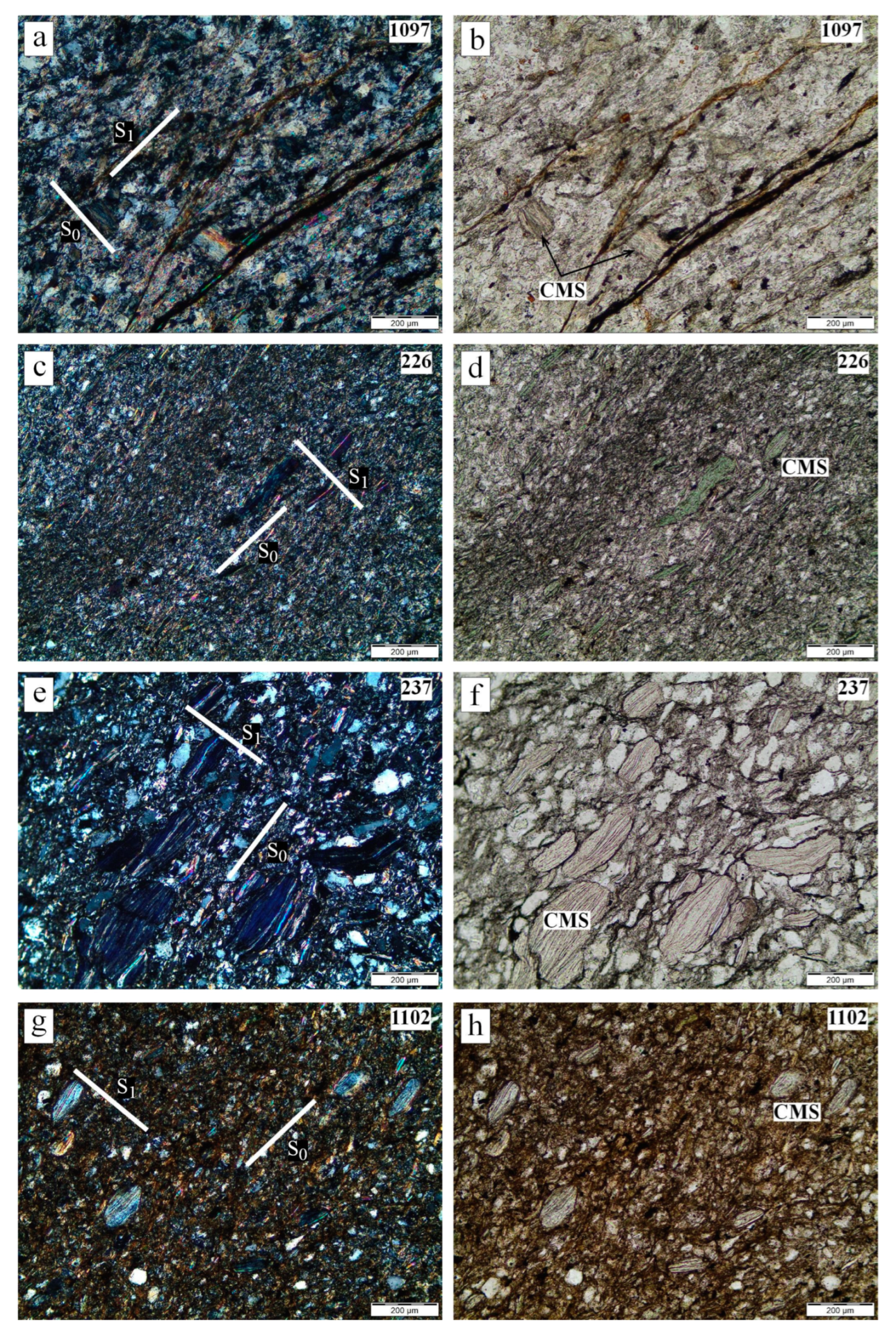

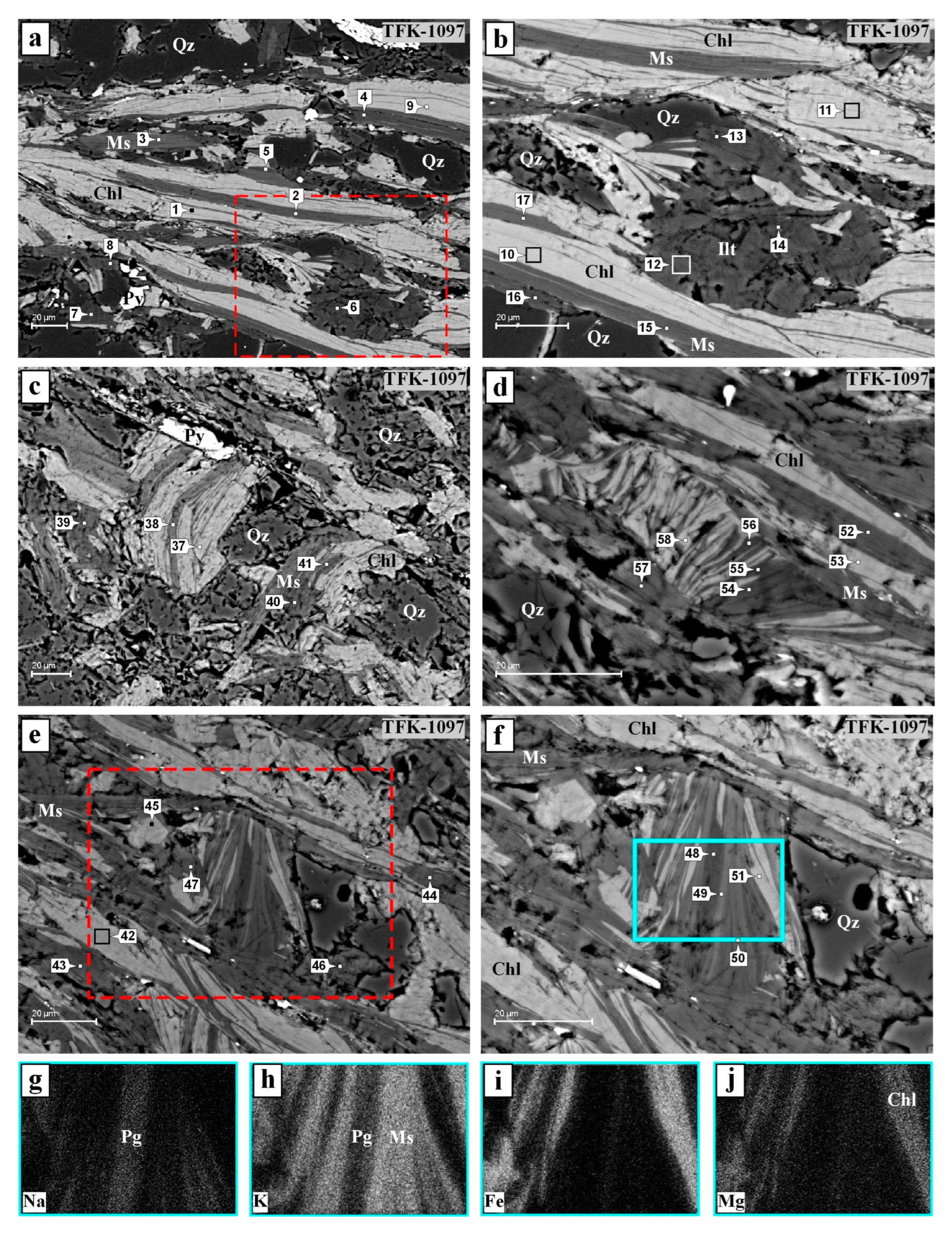
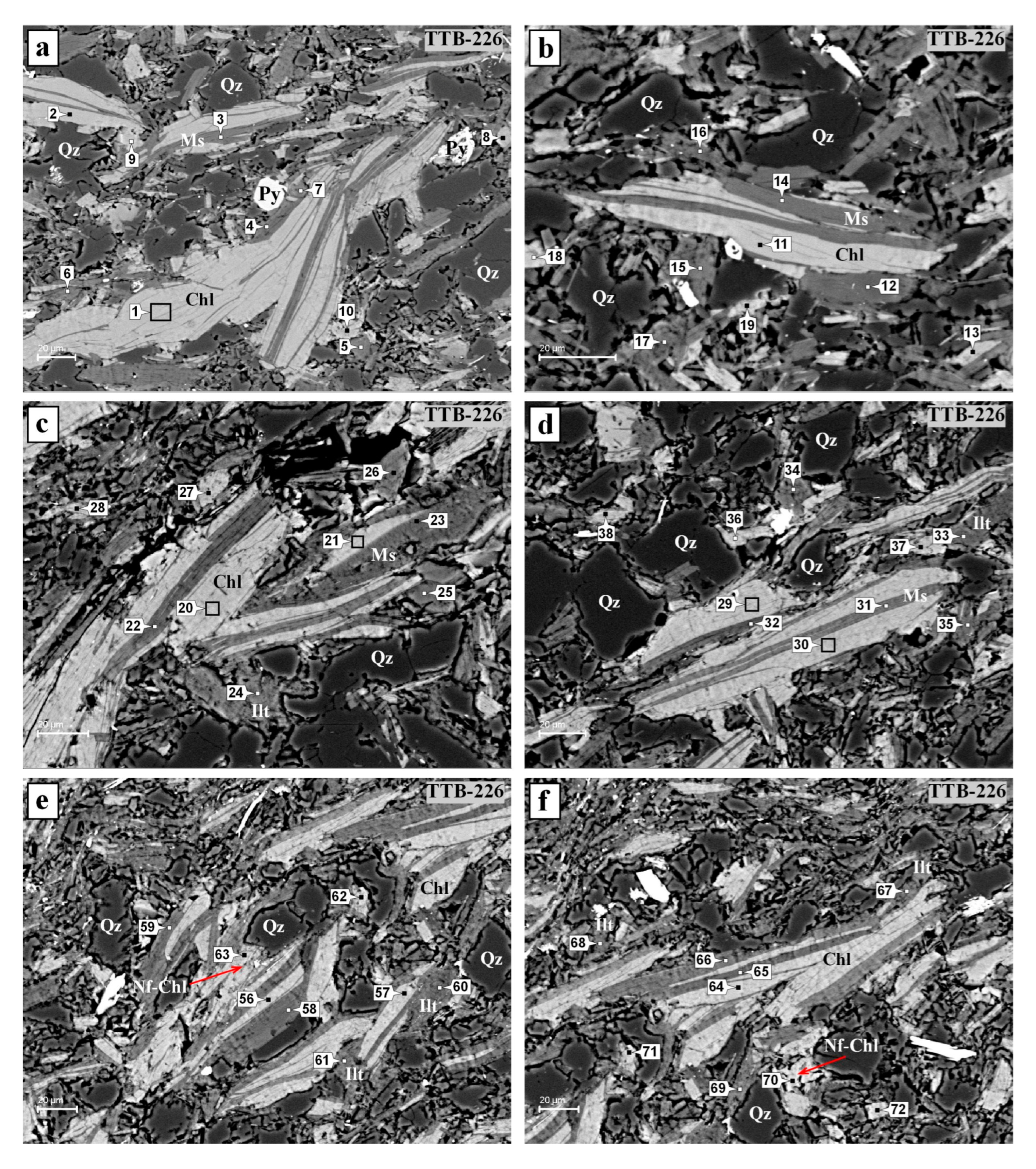


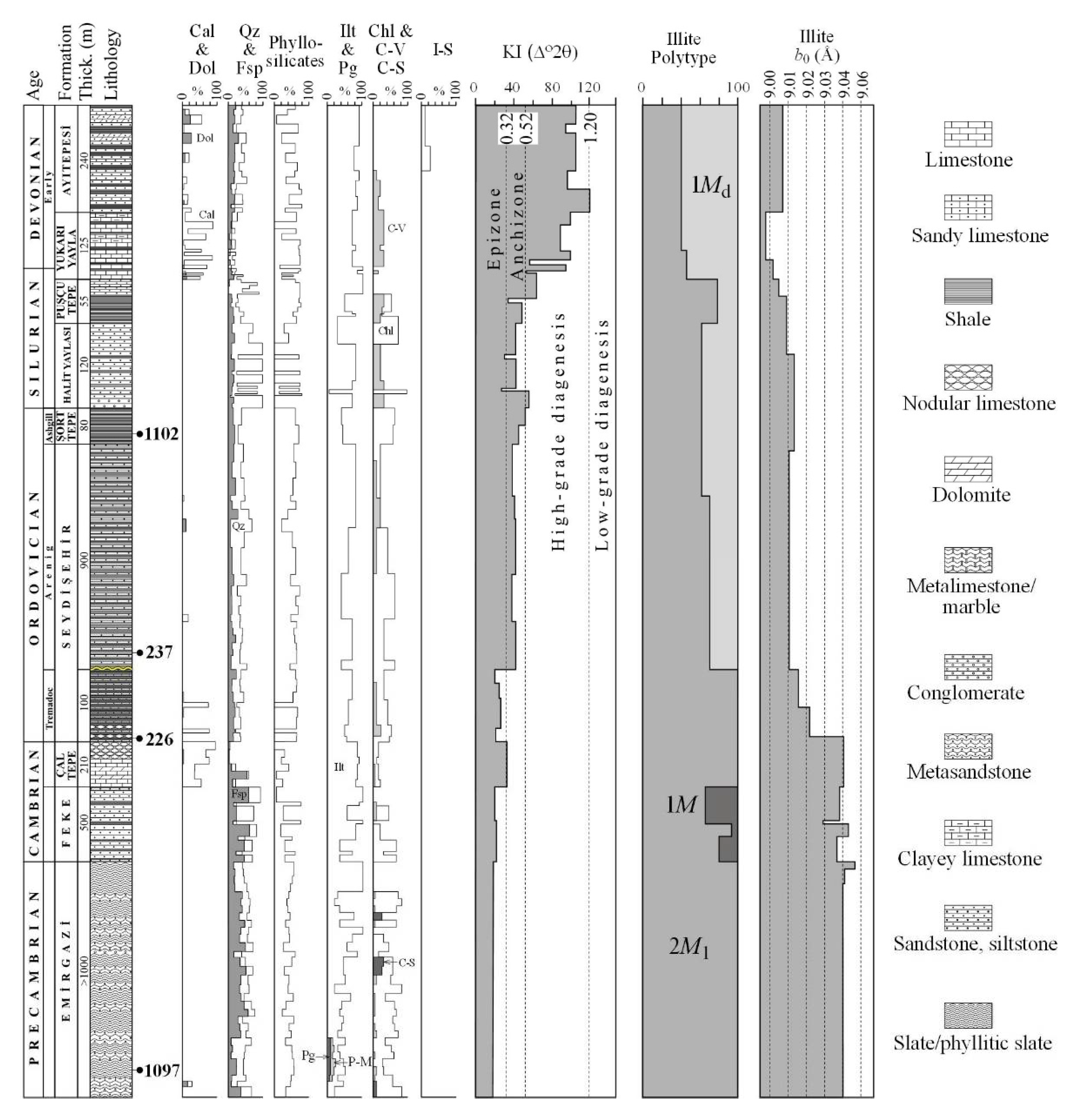
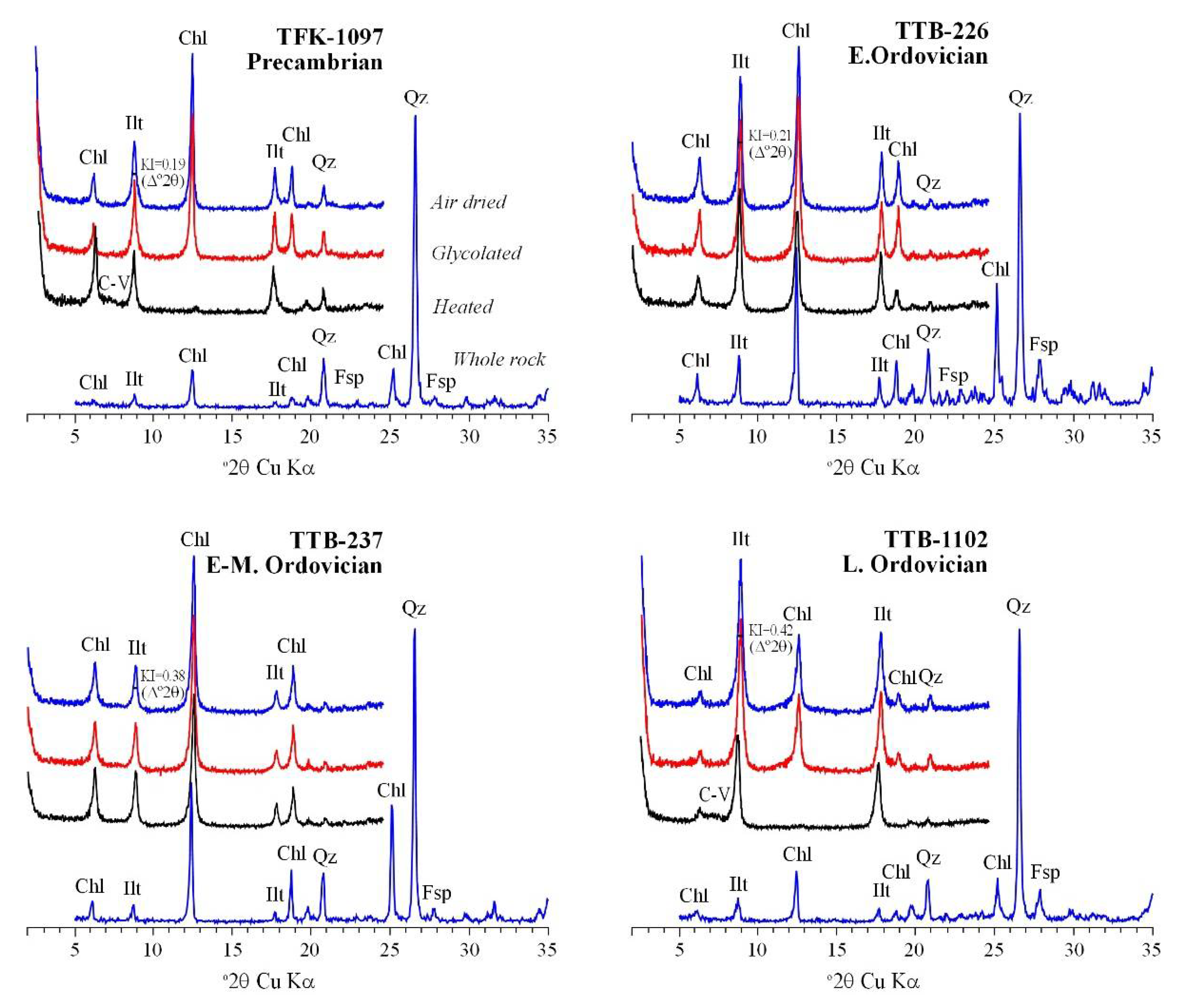
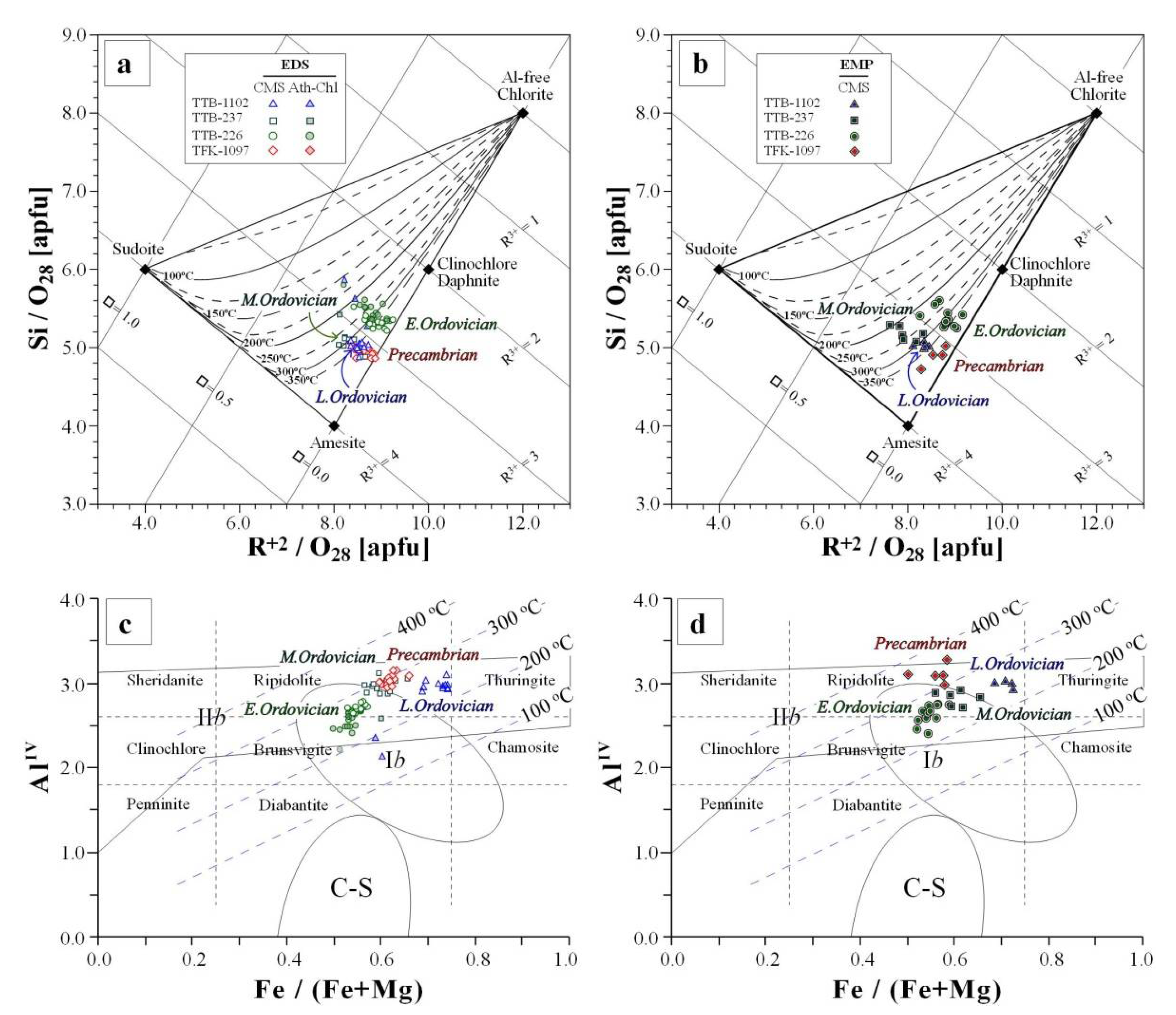
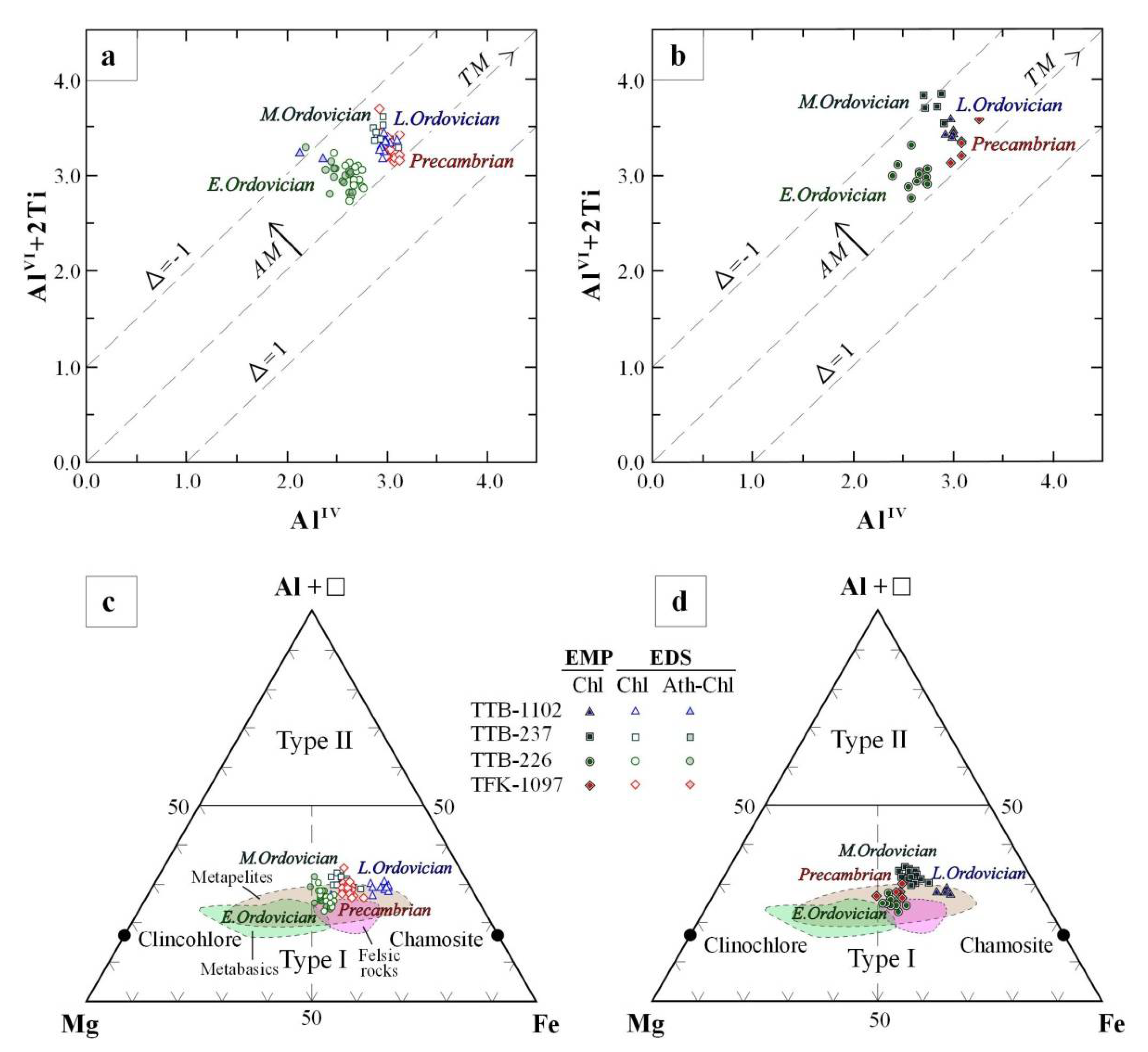
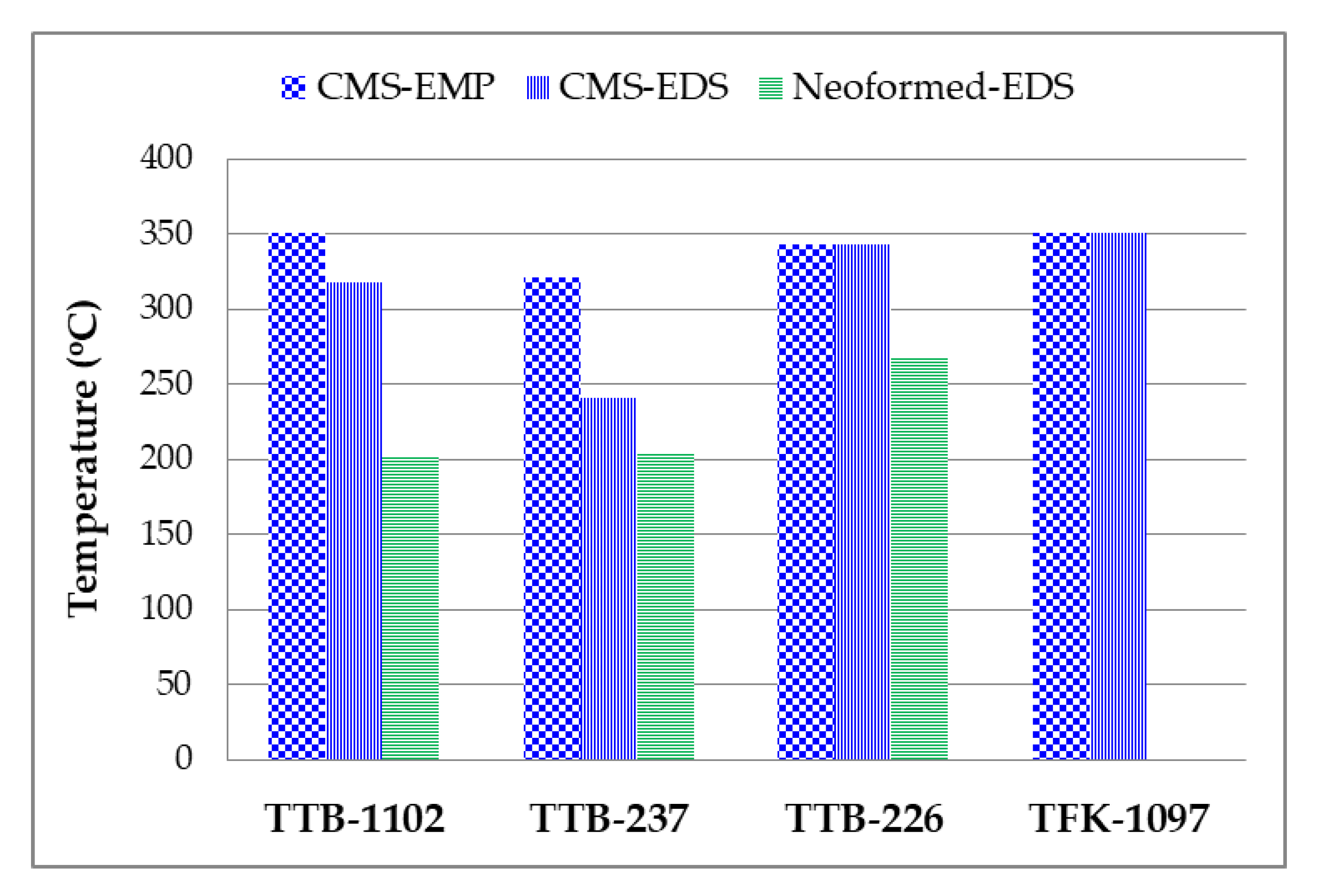


| Sample/ Formation | Rock Type/ Texture | Optical Mineralogy | Some Textural Properties |
|---|---|---|---|
| TFK-1097 Precambrian | Metasiltstone Blastopelitic | Qz + Pl + Ms + Chl + Om | Distinct orientation, roughly developed crenulation cleavage, scarce CMS are rich in muscovite |
| TTB-226 E.Ordovician | Chlorite slate Blastopelitic | Qz + Pl + Chl + Ms + Bt + Tur + Zrn + Om | Microlamination, distinct orientation, well-developed slaty cleavage, abundant CMS are rich in chlorite |
| TTB-237 E.Ordovician | Metasandstone Blastopsammitic | Qz + Pl + Chl + Ms + Tur + Zrn + Om | Abundant CMS are very rich in chlorite, distinct orientation, poorly-developed slaty cleavage |
| TTB-1102 L.Ordovician | Silty slate Blastopelitic | Qz + Fel + Ms + Om | Abundant CMS are rich in chlorite, less developed orientation formed from detrital CMS, mica and chlorite |
| Sample/ Formation | Whole Rock | Clay Fraction | Crystal–Chemical Data | ||||||||
|---|---|---|---|---|---|---|---|---|---|---|---|
| Qz | Fsp | Phl | Ilt | Chl | C-V | Pg-PM | KI | b0 | 2M1 | 1Md | |
| TFK-1097 Precambrian | 40 | 8 | 52 | 35 | 50 | 5 | 10 | 0.19 | 100 | ||
| TTB-226 E.Ordovician | 20 | 15 | 65 | 55 | 45 | 0.21 | 9.041 | 100 | |||
| TTB-237 E.Ordovician | 27 | 6 | 67 | 30 | 70 | 0.38 | 9.023 | ||||
| TTB-1102 L.Ordovician | 29 | 22 | 49 | 55 | 35 | 10 | 0.42 | 90 | 10 | ||
| EMP | EDS | ||||||||||
|---|---|---|---|---|---|---|---|---|---|---|---|
| Sample | TFK-1097 | TTB-226 | TTB-237 | TTB-1102 | TFK-1097 | TTB-226 | TTB-226 | TTB-237 | TTB-237 | TTB-1102 | TTB-1102 |
| Origin | CMS | CMS | CMS | CMS | CMS | CMS | NFC | CMS | NFC | CMS | NFC |
| (n) | (5) | (12) | (6) | (5) | (16) | (15) | (18) | (13) | (2) | (11) | (3) |
| SiO2 | 22.47 | 24.46 | 23.89 | 22.38 | 26.27 | 28.52 | 29.40 | 26.90 | 29.24 | 26.01 | 30.08 |
| TiO2 | 0.02 | 0.04 | 0.29 | 0.02 | 0.00 | 0.00 | 0.00 | 0.00 | 0.00 | 0.00 | 0.00 |
| Al2O3 | 24.97 | 21.75 | 24.96 | 24.28 | 28.34 | 25.73 | 25.22 | 28.90 | 27.58 | 27.65 | 25.35 |
| FeOtot | 26.26 | 27.03 | 26.44 | 31.50 | 33.80 | 31.36 | 30.48 | 32.19 | 31.37 | 38.11 | 31.67 |
| MnO | 0.17 | 0.15 | 0.14 | 0.09 | 0.00 | 0.00 | 0.00 | 0.00 | 0.00 | 0.00 | 0.00 |
| MgO | 11.65 | 12.07 | 9.74 | 7.21 | 11.60 | 14.39 | 14.89 | 12.01 | 11.80 | 8.22 | 12.71 |
| CaO | 0.01 | 0.01 | 0.00 | 0.01 | 0.00 | 0.00 | 0.00 | 0.00 | 0.00 | 0.00 | 0.00 |
| Na2O | 0.01 | 0.01 | 0.02 | 0.02 | 0.00 | 0.00 | 0.00 | 0.00 | 0.00 | 0.00 | 0.00 |
| K2O | 0.00 | 0.00 | 0.01 | 0.00 | 0.00 | 0.00 | 0.00 | 0.00 | 0.00 | 0.00 | 0.18 |
| Total | 85.56 | 85.51 | 85.49 | 85.50 | 100.00 | 100.00 | 100.00 | 100.00 | 100.00 | 100 | 100 |
| Si | 2.45 | 2.67 | 2.59 | 2.51 | 2.48 | 2.66 | 2.72 | 2.52 | 2.71 | 2.51 | 2.80 |
| AlIV | 1.55 | 1.33 | 1.41 | 1.49 | 1.52 | 1.34 | 1.28 | 1.48 | 1.29 | 1.49 | 1.20 |
| AlVI | 1.65 | 1.47 | 1.78 | 1.72 | 1.64 | 1.49 | 1.48 | 1.70 | 1.72 | 1.66 | 1.58 |
| Ti | 0.00 | 0.00 | 0.02 | 0.00 | 0.00 | 0.00 | 0.00 | 0.00 | 0.00 | 0.00 | 0.00 |
| Fe2+ | 2.39 | 2.47 | 2.40 | 2.95 | 2.67 | 2.44 | 2.36 | 2.52 | 2.43 | 3.08 | 2.46 |
| Mn | 0.01 | 0.01 | 0.01 | 0.01 | 0.00 | 0.00 | 0.00 | 0.00 | 0.00 | 0.00 | 0.00 |
| Mg | 1.89 | 1.96 | 1.57 | 1.20 | 1.63 | 2.00 | 2.06 | 1.67 | 1.63 | 1.18 | 1.76 |
| OC | 1.54 | 1.32 | 1.40 | 1.48 | 1.52 | 1.34 | 1.28 | 1.48 | 1.29 | 1.49 | 1.18 |
| TOC | 5.94 | 5.92 | 5.79 | 5.88 | 5.94 | 5.93 | 5.90 | 5.89 | 5.78 | 0.00 | 0.00 |
| Ca | 0.00 | 0.00 | 0.00 | 0.00 | 0.00 | 0.00 | 0.00 | 0.00 | 0.00 | 0.00 | 0.00 |
| Na | 0.00 | 0.00 | 0.00 | 0.00 | 0.00 | 0.00 | 0.00 | 0.00 | 0.00 | 0.00 | 0.00 |
| K | 0.00 | 0.00 | 0.00 | 0.00 | 0.00 | 0.00 | 0.00 | 0.00 | 0.00 | 0.00 | 0.02 |
| ILC | 0.00 | 0.00 | 0.01 | 0.01 | 0.00 | 0.00 | 0.00 | 0.00 | 0.00 | 0.00 | 0.00 |
| TLC | 0.00 | 0.00 | 0.01 | 0.01 | 0.00 | 0.00 | 0.00 | 0.00 | 0.00 | 0.00 | 0.00 |
| °C | >350 | 343 | 241 | 318 | >350 | 343 | 268 | 321 | 204 | >350 | 201 |
| EMP | EDS | ||||||||||||||||
|---|---|---|---|---|---|---|---|---|---|---|---|---|---|---|---|---|---|
| Sample | 1097 | 1097 | 226 | 237 | 1102 | 1102 | 1097 | 1097 | 1097 | 226 | 226 | 226 | 237 | 237 | 1102 | 1102 | 1102 |
| Origin | Ms | Ilt | Ms | Ms | Ms | Ilt | Ms | Ilt | P-M | Ms | Ilt | P-M | Ms | Ilt | Ms | Ilt | P-M |
| (n) | (3) | (1) | (6) | (4) | (3) | (1) | (14) | (16) | (11) | (10) | (22) | (5) | (9) | (3) | (11) | (10) | (2) |
| SiO2 | 45.44 | 46.60 | 45.46 | 44.99 | 45.04 | 44.90 | 47.87 | 48.65 | 47.97 | 49.13 | 50.08 | 48.10 | 47.58 | 50.07 | 49.65 | 49.38 | 48.17 |
| TiO2 | 0.30 | 0.22 | 0.55 | 1.37 | 0.54 | 0.42 | 0.00 | 0.00 | 0.00 | 0.00 | 0.00 | 0.00 | 0.00 | 0.00 | 0.00 | 0.00 | 0.00 |
| Al2O3 | 37.67 | 37.14 | 33.32 | 34.84 | 35.45 | 35.31 | 38.28 | 41.03 | 40.56 | 35.67 | 34.39 | 38.28 | 37.51 | 35.59 | 35.37 | 37.79 | 37.58 |
| FeOtot | 0.93 | 0.81 | 2.49 | 3.07 | 2.93 | 0.83 | 2.43 | 0.68 | 2.48 | 2.82 | 3.62 | 1.79 | 3.14 | 2.51 | 2.75 | 1.75 | 3.00 |
| MnO | 0.03 | 0.01 | 0.07 | 0.05 | 0.06 | 0.01 | 0.00 | 0.00 | 0.00 | 0.00 | 0.00 | 0.00 | 0.00 | 0.00 | 0.00 | 0.00 | 0.00 |
| MgO | 0.60 | 0.68 | 1.55 | 1.15 | 0.92 | 1.82 | 1.36 | 0.55 | 1.06 | 1.91 | 1.93 | 1.46 | 1.68 | 1.79 | 2.09 | 1.43 | 1.69 |
| CaO | 0.01 | 0.02 | 0.02 | 0.01 | 0.05 | 0.05 | 0.00 | 0.00 | 0.00 | 0.00 | 0.00 | 0.00 | 0.00 | 0.00 | 0.00 | 0.00 | 0.00 |
| Na2O | 0.80 | 1.23 | 0.50 | 0.33 | 0.64 | 0.44 | 0.95 | 2.23 | 3.91 | 0.58 | 0.27 | 1.28 | 0.60 | 0.35 | 0.45 | 0.32 | 1.49 |
| K2O | 7.77 | 7.35 | 9.47 | 8.67 | 7.65 | 9.65 | 9.11 | 6.86 | 4.02 | 9.89 | 9.70 | 9.09 | 9.49 | 9.69 | 9.68 | 9.32 | 8.07 |
| Total | 93.55 | 94.07 | 93.44 | 94.50 | 93.28 | 93.43 | 100.00 | 100.00 | 100.00 | 100.00 | 100.00 | 100.00 | 100.00 | 100.00 | 100.00 | 100.00 | 100.00 |
| Si | 3.02 | 3.07 | 3.09 | 3.02 | 3.04 | 3.03 | 3.02 | 3.01 | 2.97 | 3.12 | 3.18 | 3.03 | 3.02 | 3.16 | 3.14 | 3.10 | 3.04 |
| AlIV | 0.98 | 0.93 | 0.91 | 0.98 | 0.96 | 0.97 | 0.98 | 0.99 | 1.03 | 0.88 | 0.82 | 0.97 | 0.98 | 0.84 | 0.86 | 0.90 | 0.96 |
| AlVI | 1.98 | 1.96 | 1.77 | 1.78 | 1.86 | 1.84 | 1.87 | 2.00 | 1.93 | 1.78 | 1.75 | 1.87 | 1.83 | 1.80 | 1.78 | 1.89 | 1.83 |
| Ti | 0.02 | 0.01 | 0.03 | 0.07 | 0.03 | 0.02 | 0.00 | 0.00 | 0.00 | 0.00 | 0.00 | 0.00 | 0.00 | 0.00 | 0.00 | 0.00 | 0.00 |
| Fe2+ | 0.05 | 0.04 | 0.14 | 0.17 | 0.17 | 0.05 | 0.13 | 0.04 | 0.13 | 0.15 | 0.19 | 0.09 | 0.17 | 0.13 | 0.15 | 0.09 | 0.16 |
| Mn | 0.00 | 0.00 | 0.00 | 0.00 | 0.00 | 0.00 | 0.00 | 0.00 | 0.00 | 0.00 | 0.00 | 0.00 | 0.00 | 0.00 | 0.00 | 0.00 | 0.00 |
| Mg | 0.06 | 0.07 | 0.16 | 0.12 | 0.09 | 0.18 | 0.13 | 0.05 | 0.10 | 0.18 | 0.18 | 0.14 | 0.16 | 0.17 | 0.20 | 0.13 | 0.16 |
| OC | 0.21 | 0.15 | 0.02 | 0.19 | 0.21 | 0.07 | 0.13 | 0.18 | 0.24 | 0.01 | 0.00 | 0.08 | 0.14 | 0.02 | 0.02 | 0.12 | 0.13 |
| TOC | 2.10 | 2.08 | 2.10 | 2.14 | 2.15 | 2.09 | 2.13 | 2.09 | 2.16 | 2.11 | 2.13 | 2.10 | 2.15 | 2.11 | 2.12 | 2.11 | 2.15 |
| Ca | 0.00 | 0.00 | 0.00 | 0.00 | 0.00 | 0.00 | 0.00 | 0.00 | 0.00 | 0.00 | 0.00 | 0.00 | 0.00 | 0.00 | 0.00 | 0.00 | 0.00 |
| Na | 0.10 | 0.16 | 0.07 | 0.04 | 0.08 | 0.06 | 0.12 | 0.27 | 0.47 | 0.07 | 0.03 | 0.16 | 0.07 | 0.04 | 0.06 | 0.04 | 0.18 |
| K | 0.66 | 0.62 | 0.82 | 0.74 | 0.66 | 0.83 | 0.73 | 0.54 | 0.32 | 0.80 | 0.79 | 0.73 | 0.77 | 0.78 | 0.78 | 0.75 | 0.65 |
| ILC | 0.76 | 0.78 | 0.89 | 0.79 | 0.75 | 0.90 | 0.85 | 0.81 | 0.79 | 0.87 | 0.82 | 0.89 | 0.84 | 0.82 | 0.84 | 0.79 | 0.83 |
| TLC | 0.76 | 0.78 | 0.89 | 0.79 | 0.75 | 0.90 | 0.85 | 0.81 | 0.79 | 0.87 | 0.82 | 0.89 | 0.84 | 0.82 | 0.84 | 0.79 | 0.83 |
Publisher’s Note: MDPI stays neutral with regard to jurisdictional claims in published maps and institutional affiliations. |
© 2022 by the authors. Licensee MDPI, Basel, Switzerland. This article is an open access article distributed under the terms and conditions of the Creative Commons Attribution (CC BY) license (https://creativecommons.org/licenses/by/4.0/).
Share and Cite
Bozkaya, Ö.; Yalçın, H. Mineral Chemistry of Low-Temperature Phyllosilicates in Early Paleozoic Metaclastic Rocks, Eastern Tauride Belt, Türkiye. Minerals 2022, 12, 1088. https://doi.org/10.3390/min12091088
Bozkaya Ö, Yalçın H. Mineral Chemistry of Low-Temperature Phyllosilicates in Early Paleozoic Metaclastic Rocks, Eastern Tauride Belt, Türkiye. Minerals. 2022; 12(9):1088. https://doi.org/10.3390/min12091088
Chicago/Turabian StyleBozkaya, Ömer, and Hüseyin Yalçın. 2022. "Mineral Chemistry of Low-Temperature Phyllosilicates in Early Paleozoic Metaclastic Rocks, Eastern Tauride Belt, Türkiye" Minerals 12, no. 9: 1088. https://doi.org/10.3390/min12091088
APA StyleBozkaya, Ö., & Yalçın, H. (2022). Mineral Chemistry of Low-Temperature Phyllosilicates in Early Paleozoic Metaclastic Rocks, Eastern Tauride Belt, Türkiye. Minerals, 12(9), 1088. https://doi.org/10.3390/min12091088






